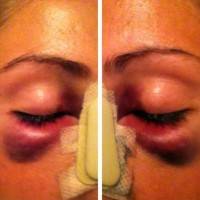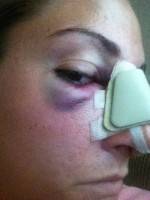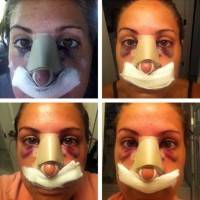Recovery time for rhinoplasty
Rhinoplasty is an outpatient procedure. Most patients will wear a splint for 7 days, and thus will limit social engagement during this time – that is not always the case as some patients are comfortable being seen with a splint.
If the nasal bones are not manipulated, then sometimes a splint can be avoided and only flesh colored steri strips used. Surgeons differ on when exercise and full activity can resume, and each patient should check with his/her surgeon. I believe these can resume early (7 days). (P. Craig Hobar, MD, Dallas Plastic Surgeon)
The immediate recovery after a rhinoplasty is about 7 days.At this point, most patients can return to work. The final result is at one year. (Andres Bustillo, MD, FACS, Miami Facial Plastic Surgeon)
In general, there are 3 phases of recovery – the acute post-surgical period during the first 7-14 days after surgery, the subacute period for the following 3 months, and then the final phase which lasts for the remainder of the year.
Most patient’s swelling and bruising largely resolves during that first phase, and most patients *feel* good enough to go back to work after the first week.
Oftentimes, patients will take additional time if they still have some swelling or bruising in place, for example. Your recovery also depends somewhat on what is done during surgery, for example, if it is necessary to perform osteotomies to reshape the bony part of the nose.
Different surgeons make different recommendations and set expectations differently, so be sure to seek a consultation from a rhinoplasty surgeon whom you are considering for the procedure. (Bryan Correa, MD, Houston Plastic Surgeon)
Rhinoplasty Recovery Timeline
Rhinoplasty is an outpatient procedure, which means you go home the same day as your surgery. Most surgeons will place steri strips (pieces of tape) and a cast or splint on your nose. You may or may not also have internal nasal packing. Generally, nasal packing if present is removed on post-operative day 1.
Most surgeons remove the nasal splint 7 days after surgery. Most patients return to work or school approximately one week after surgery, although some people require makeup or concealer if they have bruising around the eyes.
Much of the swelling has subsided within several weeks, although it takes nearly a year for all swelling to dissipate. (Lara Devgan, MD, MPH, New York Plastic Surgeon)
Average recovery times after rhinoplasty -the skinny
Average time off of work 1-2 weeks. Resume normal activities 1-2 weeks. Resume light exercise 2 weeks. Resume contact sports 6-8 weeks. Bruising: majority gone in 2-3 weeks. Swelling: 80% gone in 1-2 months. Remaining 10-20% may take up to 1 year (Joseph Shvidler, MD, Tacoma Facial Plastic Surgeon)
Recovery period and Downtime after rhinoplasty / nosejob surgery
The period of recovery is largely dependant on the surgical technique used as well as the patient’s response to surgery. Rhinoplasty is not a very painful surgery. Most patients only experience headaches and some throbbing.
You can expect to have mild bleeding for a couple of days and a nasal cast for 5-7 days which is mainly used to decrease the amount of swelling. Other than the patient’s body, the three main factors determining healing times are as follows:
- whether the surgery is done closed (no external incision)
- if and how osteotomies are performed.
- the extent of dissection of the skin/muscle on the nose.
Closed rhinoplasties tend to have a much shorter healing time. Although most surgeons have the ability to do some noses closed, the majority do their surgeries open. The only way to determine this is to look at before and after pictures as well as descriptions of those photos. It’s also nice to see short term and long term follow up photos.
Aside from all of this a good rule of thumb is that for a nicely performed rhinoplasty no one will notice at 2 weeks. It will be 80% healed at 3 months. 90% at 6 months. 99% at 1 year and 100% at 2 years. (Ben Talei, MD, Beverly Hills Facial Plastic Surgeon)
Downtime for Rhinoplasty?
Rhinoplasty recovery comes in two forms: physical and psychological. Patients in my practice wear a fiberglass splint for 1 week, followed by a 2nd week of tape. Since this is the same form of bandaging one would have after a nasal fracture, I counsel patients who are sensitive about this appearance that they should offer this as an explanation for how they look.
For 6 weeks after a Rhinoplasty, you should avoid contact sports or situations in which the alignment of your nose could be affected (especially if you have osteotomies). Depending on the amount of intra-nasal work required, most patients can expect 2-8 weeks of nasal stuffiness.
Generally speaking, most patients do not appear post-surgical when their tape is removed at 2 weeks. Adjusting to the “new” appearance of your nose can range from immediate happiness to an adjustment period of several months.
Please bear in mind that minor swelling present in your nose can last for up to year or longer. To give you an idea of recovery from Rhinoplasty, I have posted a link below to a review by one of my Rhinoplasty patients (Stephen Prendiville, MD, Fort Myers Facial Plastic Surgeon)
Rhinoplasties often involve delicate repositioning of nasal tissues with internal sutures and/or grafts. Protective splints or bandages may be applied for up to 2 weeks and then splints worn part-time may be advised for several more weeks to protect the nose.
However you should be able to return to work without a splint by 2 weeks. To allow the nasal tissues adequate time to heal, you should be careful of your nose for about 8 weeks after nose job. This does not mean that you cannot be out in public much sooner. The nose at two weeks generally does not draw attention.
Most importantly, the final appearance of the nose may not be apparent for a year so do not judge your result too early. (John Zavell, MD, FACS, Toledo Plastic Surgeon)
The initial recovery time for nose job takes one week. At that point the external splint and internal splint (if applicable) are removed along with any external sutures.
Most patients are quite comfortable returning to school, work, social activities at this time. Strenuous activities should be avoided for another week (2 weeks total) and contact sports should be avoided longer (e.g. 6 weeks).
Patient experiences with bruising range from very light to mild (most) to much darker. Bruising may be minimized by attention to peri-operative medications and supplements (your doctor and the nursing staff will give you detailed information on this), using cold packs immediately after surgery and restricting activity for several weeks post-op.
Despite all of these efforts cosmetic camouflage of bruises may be needed by some patients. Bruising can also be lightened with certain vascular lasers (e.g. excel V).
The final result may not be apparent for many months as it takes significant time for mild swelling or edema of the tip of the nose to go away. (J. David Holcomb, MD, Sarasota Facial Plastic Surgeon)
Nose job recovery time and downtime
There are different levels / degrees of recovery time after nose job. In my practice we do not use bandages or nasal packing, but there is a small cast on the nose. The cast comes off in one week. I limit the patients physical activities (bending, lifting, straining, and cardio) and have them sleep head elevated for about 4 weeks.
This is to allow the swelling to resolve and prevents bleeding. There is limited bruising (black-eyes) and if it does occur it usually resolves within the first week. That being said most patients are out and about within the first week or so, and with limiting their activities they look and feel good.
The swelling after nose job will last one full year! However 75% of that swelling is usually gone within the first 6 weeks. (James Shire, MD, Chattanooga Facial Plastic Surgeon)
Recovery after Rhinoplasty
After your nose job, the nasal splint and bandages are typically removed 7 days after your surgery. The nose will appear swollen at this time but you will be able to go out in public and return back to daily activities.
I typically advise patients that are physically active to refrain from agressive cardio or weight lifting for a full 14 days.
My patients usually return to work after the splint and sutures are removed at their one week postoperative visit.
It is important to keep in mind that healing will continue to occur in the nose for weeks to months, although about 80% of the swelling is resolved 2-3 weeks after surgery. There is always a chance for some bruising to occur and this also takes a couple weeks to completely resolve. For that reason, I recommend not planning your surgery within two months of any major events (i.e. weddings, photo shoots, etc.). (Michael T. Somenek, MD, FACS, Washington DC Facial Plastic Surgeon)
Nose job recovery
The splint applied after nose job is typically removed after 6 days. Swelling and bruising are significantly improved at two weeks. It takes several months for most of the swelling to improve and up to a year for complete resolution. (Austin Hayes, MD, Portland Plastic Surgeon)
Time for nose job recovery?
Most patients will need 7-10 days of “social downtime”, during which they may have mild bruising and will be wearing the nasal splint and have small sutures. Most can return to work at that time and to full activity by 3 weeks. Swelling is dramatically improved by 6 weeks, but mild swelling can persist for months. Good luck! (Dustin L. Reid, MD, Austin Plastic Surgeon)
Nose job recovery and downtime
There is obvious differences among surgeons in terms of the types of dressings and length of time that they are on following surgery.
For my patients, I place a small dressing/splint on the bridge of the nose which remains on for 6 or 7 days.
I do not put any packing in the nose, packing has traditionally been used in nasal surgery and is one of the most painful aspects postoperatively.
In my opinion, there is usually no benefit of placing packing in the nose. There is tremendous variation in the healing among patients, but most feel it is not painful.
Commonly, patients describe recovery as being “uncomfortable,” with feelings of congestion and pressure as one has when they have a cold. At one week after surgery the dressing and sutures are removed, at that point the way you look is a function of the degree of bruising and swelling.
On average most, if not all, bruising has resolved within 7 to 10 days. Makeup can be applied once the dressing is removed. In terms of the shape and size of the nose, most patients see a significant change on their profile that they are happy with once the dressing is removed.
From the front, looking straight into a mirror, most people feel their nose still appears wider than they would ultimately like; at one week after surgery this is an expected due to swelling.
Once the dressing is removed at one week patients look fine to go out in public. Most patients are back to work or school within 10 days from surgery.
When patients return one month after surgery, they generally like the overall result, despite the fact that swelling will continue to go down. Swelling continues to resolve over many months, by a year you generally see the final result.
This does not mean patients look swollen for a year, the longer term effects of swelling resolution tend to be subtle. (Robert Glasgold, MD, East Brunswick Facial Plastic Surgeon)
Recovery after nose job is generally between 10 days and 2 weeks.
After nose job, the time until you are looking and feeling normal enough to resume you usual daily activities is around 10 days to 2 weeks. Every surgeon has their own post-operative timeline, but just to give you an idea – I usually perform rhinoplasties on Wednesdays.
My patients generally plan to take off Wednesday through Friday, and then one additional week. By the following Monday (approximately 12 days after surgery) they are looking and feeling well enough to go back to work without telling anyone that they had surgery. I keep a cast on the nose (and in some cases stitches under the nose or around the alas) for one week.
Bruising around the eyes goes away by 10 days to 2 weeks depending upon your ability to heal. In terms of pain, I’ve heard from many patients that they barely use pain medication after the surgery. If I am also performing septoplasty, sinus surgery, or inferior turbinate reduction, I tell patients to expect to be pretty congested for 2 weeks following surgery. (Dara Liotta, MD, New York Facial Plastic Surgeon)
Typical recovery time from nose job
Recovery from nose job is fairly predictable. What I tell my patients is there is essentially three phases of recovery.The first phase is the first week in which they will typically have a bandage on their nose made up of some light brown (flesh colored) tape covered by a firm splint.
The nose is not packed unless there was an issue with bleeding during or at the end of the procedure. (Packing is extremely rare, given the more contemporary nose job techniques now employed as well as the medications utilized in the OR that minimize bleeding.)
Because the nose is not typically packed, the postop pain is minimal, and feels more like congestion from a head cold. Even if you have zero bruising and swelling, the bandage is a dead giveaway, so most patients lay low socially the first 7 seven days. At one week, the dressing is delicately removed in the office and the nostrils and skin cleaned.
At this point there is obviously some swelling, and I tell my patients in advance that between the first and sixth week I wouldn’t have any keepsake photos taken, but will be fine for their normal day to day activities except for any contact sports. I advise them not to bump the nose or wear glasses for the first six weeks as the bones heal into their new position. During that second week they may require some makeup depending on if they bruised, and if so to what degree.
Our Esthetician routinely sees every nose job patient at their one week postop appointment, and if some camouflaging is indicated, helps the patient with that. The last phase is between 6 weeks and one year. At six weeks, there is typically still a small amount of swelling noted, and is typically in the tip of the nose. This is swelling that usually only I and the patient are aware of, but not anyone else. Over the remainder of that year this small amount of swelling waxes and wanes and eventually is permanently gone. There are no restrictions from glasses or activities after six weeks. (Burke Robinson, MD, Atlanta Facial Plastic Surgeon)



